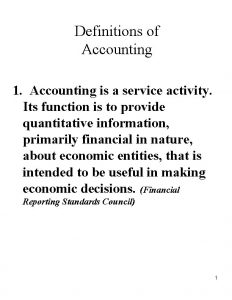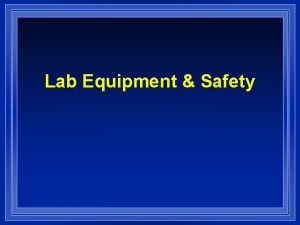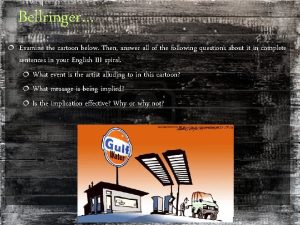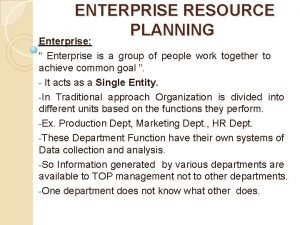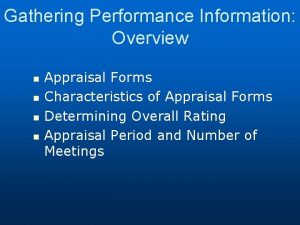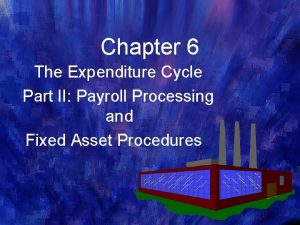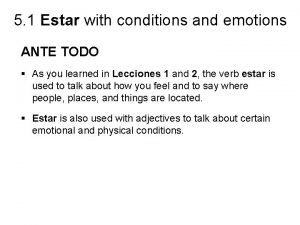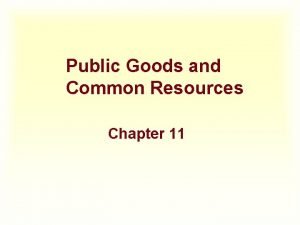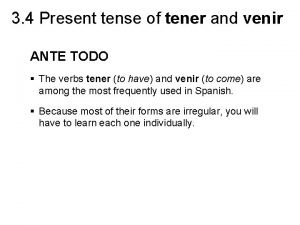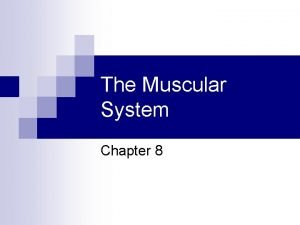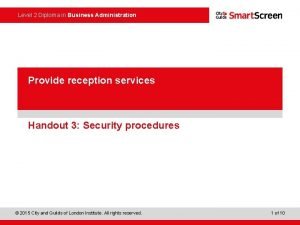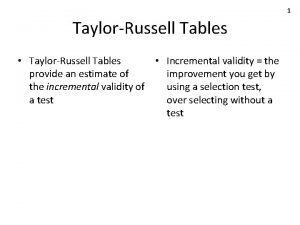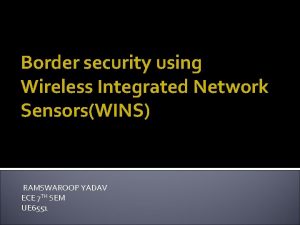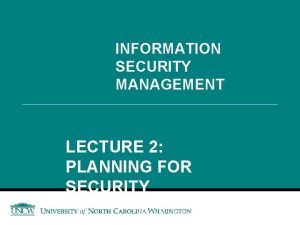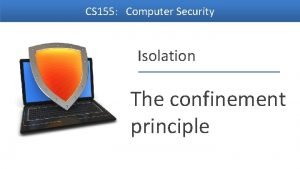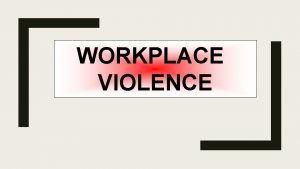Purpose of Watchstanding Provide Security 6 4 Provide































































- Slides: 63


Purpose of Watchstanding Provide Security 6 -4

Provide security to prevent: (a)Sabotage (b)Damage to property (c)Theft (d) Unauthorized personnel entering a restricted area

Purpose of Watchstanding Ensure the safety of personnel and equipment 6 -5

Ensure the safety of personnel and equipment; e. g. , check for fire, flooding, and machinery problems.

Purpose of Watchstanding Provide a key role in fulfilling the Sea Cadet and Navy mission 6 -6

A watchstander has many responsibilities

6 -8

Prepare for watch 15 minutes prior to assigned watch time. Report to watch on time!

Receive information from the off going watchstander.

Quarter Deck Watch: Main Entrance 1 hour Duty Station 0800 hrs to 1200 hrs 1300 hrs to 1700 hrs Fire Watch: All Berthing Areas 2 hour Duty Station 2100 hrs to 0430 hrs

Quarter Deck Watch Responsibility: * Security and accountability of main entrance of the facility. * Request a valid ID from guests and personnel. * Log all Guests and Personnel entering and leaving the facility. * Report via radio or telephone to ( OOD ) Officer of the Deck all guest that require escort into the facility.

Use customary Navy terminology when writing reports and talking to others.

Answer the telephone or radio using proper procedures. Answer the phone: Quarter Deck, Recruit Smith speaking. Radio Transmission: Quarter Deck to OOD, ( The reply will be: OOD go ahead ).

Take appropriate action for any emergency; e. g. , fire, flooding, or bomb threat. Report to OOD - Officer of the Deck Immediately or any alternate officer if no reply via radio or telephone

Remain at your watchstation until relieved.

Follow all legal orders.

Consequences of Improper Watchstanding a. Improper watchstanding for any reason is inexcusable. b. You will be held accountable for violations of any rule or regulation which governs your watch. 6 -22

Consequences of Improper Watchstanding (cont) C. Improper watchstanding could result in: (1) Non-Judicial Punishment. (2) Reduced chance of advancement. (3) Disqualification from the watch. (4) Counseling 6 -23

Official Watch Log a. A complete chronological log. b. Used to record every circumstance of importance or interest. c. Can be used as evidence before courts and other legal bodies. 6 -24

Procedures for Making Log Entries a. Log entries are entered with ballpoint pen in black ink. b. Entries are made in capital block letters. c. All entries must be complete and accurate, written in standard Navy language. 6 -25

Procedures to Correct Errors 6 -26

d. Procedures to correct errors. (1) There are to be no erasures. (2) Draw a single line through the mistake, horizontally, so that it remains legible. (3) Initial the mistake. (4) Continue the entry correctly. (5) The watchstander who signs the log is the only person authorized to make corrections, additions, or changes to the log.

Assuming/Relieving the Watch 6 -28

e. Making a log entry for assuming/relieving the watch. (1) The first line after the heading should relate to assuming the watch. (2) Upon completion of the watch, the last line shall read "Properly relieved by" (oncoming watches name). (a) (b) Sign your name on the next line. Print your name under your signature.

Late Entries 6 -29

f. Making late entries (1) There are times when events occur too quickly for the watchstander to make entries in the log. (2) To insert the entry when there is time would cause the log to lose its chronological sequence.

(3) Steps for recording late entries: (a) In the left margin corresponding to where the entry should have been, place an asterisk (*). (b) Enter the "late entry" on the next available line and place another asterisk in the left margin. (c) Put the original time the event took place followed by the information.

Ending a page 6 -30

g. Ending a page (1) Frequently, the end of a 24 -hour day will not be at the bottom of a log page. (2) From the bottom right of the last line of information, draw a diagonal line to the lower left corner of the page. (3) Print on the diagonal line "NO FURTHER ENTRIES THIS PAGE" and initial the entry.

Barracks Security Watch 6 -36

Barracks security watch (1) This watch provides for: (a) Protection against fire. (b) The safety of personnel and material.

(2) The watch is responsible for: (a) Knowing and carrying out the provisions of the fire bill, emergency bill, barracks regulations (b) Maintaining good order and discipline. Note: Barracks security is usually a roving watch.

Types of Orders General Orders (1)Cover routine and foreseeable situations. (2)Same for all watchstanders. (3)Never change. 6 -9

Types of Orders (continued) Special Orders (1)Cover a certain time or situation. (2)Cover specifics of a particular post. (3)May be written or verbal. 6 -10

(a) 1. 2. 3. Written orders Remain in effect until canceled or changed. Are called "Standing Orders. " Are normally kept in a pass down log for each watchstation. Read the pass down log before assuming the watch.

(b) Verbal orders 1 2 Come from a higher authority; e. g. , CDO, OOD, etc. Usually cover a situation of very short duration.

6 -11

A sentry is a person that stands guard duty over places such as: (1) Navy bases (2) Ships (3) Aircraft hangars (4) Sea Cadet Training Facilities

Sentries are required to follow eleven general orders.

6 -12

1. To take charge of this post and all government property in view. a) Once you assume the duty, you are responsible for your post.

6 -13

(2) To walk my post in a military manner, keeping always on the alert and observing everything that takes place within sight or hearing. (a) You must be constantly aware and alert (b) Do NOT fall asleep when standing watch.

6 -14

(3) To report all violations of orders I am instructed to enforce. (a) Failure to report violations of orders by others makes you just as guilty as the offender.

“… All Is Well!” 6 -15

(4) To repeat all calls from posts more distant from the guardhouse than my own. (a) Perimeter watches may be posted along the inside of a fenced area, each watch having a section of a fence assigned. (b) Each post watch would have to report in ("POST 3, All Secure"). Without radios, the call would have to be passed to be heard at the guardhouse

6 -16

(5) To quit my post only when properly relieved. (a) If your watch is over but your relief has not arrived, notify the watch supervisor and remain on watch until you are properly relieved.

6 -16

(6) To receive, obey, and pass on to the sentry who relieves me all orders from the Commanding Officer, Command Duty Officer, Officer of the Deck, officers, and petty officers of the watch. (a) Failure to receive, obey, and pass on all orders could result in grave emergencies or death.

6 -17

(7) To talk to no one except in the line of duty. (a) If you are talking to someone, you are not paying attention to your post (b) You must remain alert at all times.

6 -18

(8) To give the alarm in case of fire or disorder. (a) You must know the fire procedures for your post and be able to give the alarm quickly and efficiently.

“Officer of the deck - I don’t understand…” 6 -19

9) To call the Officer of the Deck in any case not covered by instructions. (a) If you are unsure about what to do, call the supervisor of the watch for instructions.

6 -20

(10) To salute all officers, and all colors and standards not cased. (a) A salute is a sign of respect. (b) Colors and standards both refer to the American flag. (c) Not cased refers to a flag that is flying freely.

6 -21

(11) To be especially watchful at night, and during the time for challenging, to challenge all persons on or near my post and to allow no one to pass without proper authority.

(a) You are required to properly challenge and identify all persons on your post. (b) Report any suspicious behavior; no one is above the rules
 Private security
Private security Visa international security model
Visa international security model Building security software
Building security software What is the osi security architecture?
What is the osi security architecture? Electronic mail security in network security
Electronic mail security in network security Security guide to network security fundamentals
Security guide to network security fundamentals Security guide to network security fundamentals
Security guide to network security fundamentals Cnss model
Cnss model Security guide to network security fundamentals
Security guide to network security fundamentals Wireless security in cryptography
Wireless security in cryptography Electronic commerce security
Electronic commerce security What is a security survey
What is a security survey On purpose sentence
On purpose sentence Specific purpose statement
Specific purpose statement Accounting is a service activity its function is to provide
Accounting is a service activity its function is to provide Context clues provide apex
Context clues provide apex Chapter 4 choosing a form of business ownership
Chapter 4 choosing a form of business ownership Sits on the iron ring to provide a place to stand a beaker
Sits on the iron ring to provide a place to stand a beaker Analyze the cartoon below then provide answer
Analyze the cartoon below then provide answer How to set-up trays and trolleys at room service?
How to set-up trays and trolleys at room service? An enterprise is a group of people
An enterprise is a group of people Paradigm of distributed computing
Paradigm of distributed computing Verbs of opinion
Verbs of opinion Gathering performance information
Gathering performance information Organizational controls provide
Organizational controls provide Which animal provide us wool
Which animal provide us wool Accounting records that provide the audit trail for payroll
Accounting records that provide the audit trail for payroll Visual elements color
Visual elements color Intentalo provide the appropriate forms of the adjectives
Intentalo provide the appropriate forms of the adjectives Moving and holding a hot beaker
Moving and holding a hot beaker Intentalo provide the present tense forms of estar
Intentalo provide the present tense forms of estar Service housekeeping request
Service housekeeping request Free rider problem
Free rider problem Characteristics of dss in mis
Characteristics of dss in mis In spanish
In spanish Intentalo arturo y eva
Intentalo arturo y eva Iot design methodolgy is to define the
Iot design methodolgy is to define the Product-oriented vision statements provide managers with
Product-oriented vision statements provide managers with A panel discussion is designed to provide an opportunity
A panel discussion is designed to provide an opportunity Semaphore provide a primitive yet powerful and flexible
Semaphore provide a primitive yet powerful and flexible Descriptive adjective
Descriptive adjective Beakers hold
Beakers hold Tener or venir
Tener or venir Define people as media
Define people as media What advantages did rome's location offer?
What advantages did rome's location offer? Dreaded type of context clue
Dreaded type of context clue If a laboratory fire erupts, immediately
If a laboratory fire erupts, immediately Latent time
Latent time A dermatologist and an oncologist both provide
A dermatologist and an oncologist both provide G in welding
G in welding Provide reception services
Provide reception services How did valet prepare guest clothes
How did valet prepare guest clothes Sits on the iron ring to provide a place to stand a beaker
Sits on the iron ring to provide a place to stand a beaker Tn wic food list 2021
Tn wic food list 2021 The united states ought to provide a universal basic income
The united states ought to provide a universal basic income Striker lab equipment
Striker lab equipment Taylor-russell tables provide evidence of
Taylor-russell tables provide evidence of Wireless integrated network sensors
Wireless integrated network sensors Information security implementation
Information security implementation Troy check printing software
Troy check printing software Confinement principle in computer system security
Confinement principle in computer system security Principles of collective security
Principles of collective security Johnnie woods security
Johnnie woods security Usi campus security
Usi campus security














